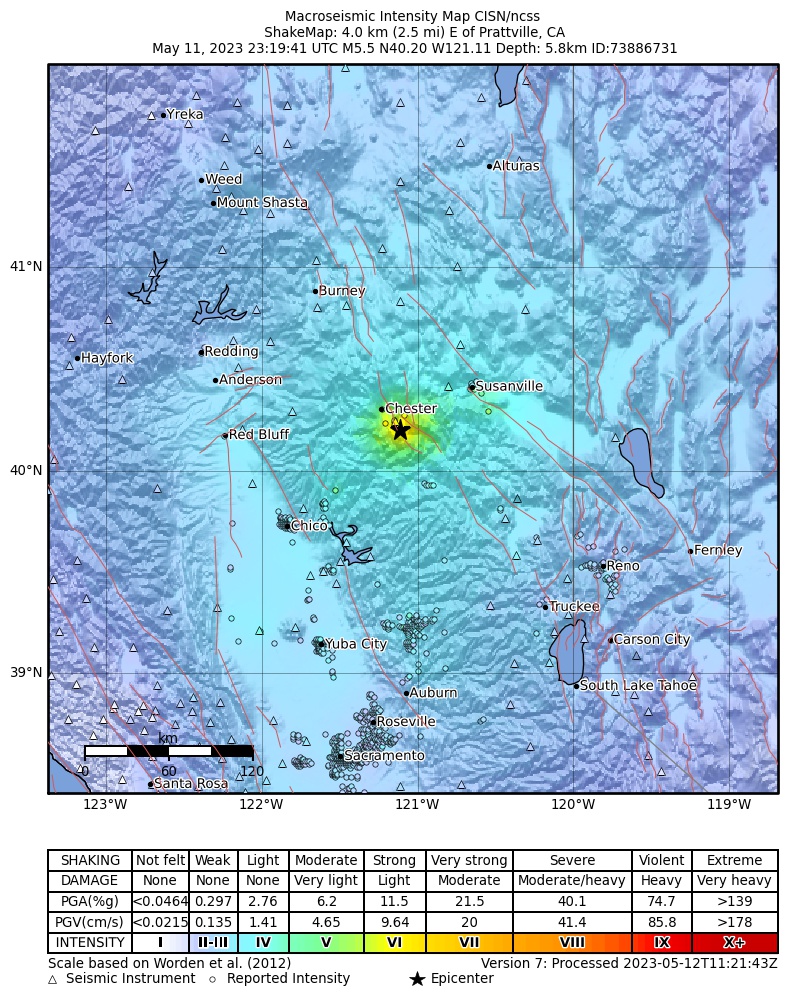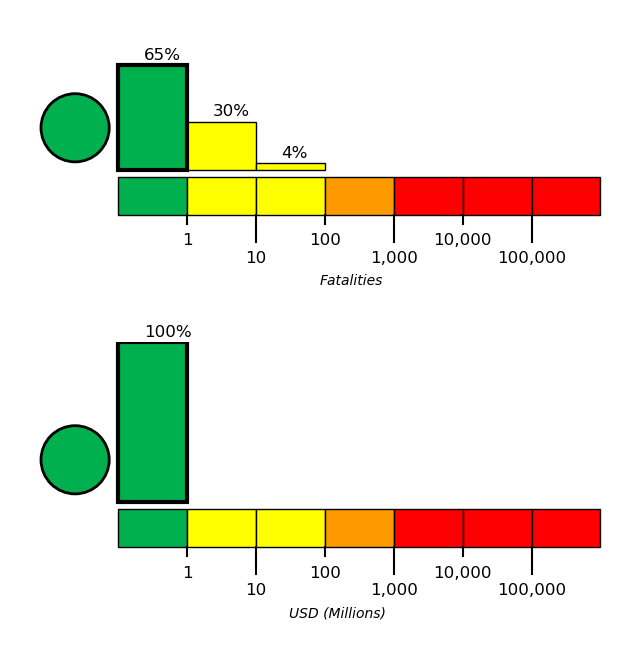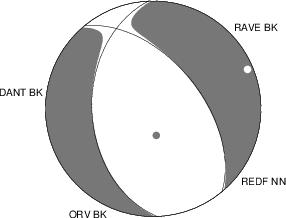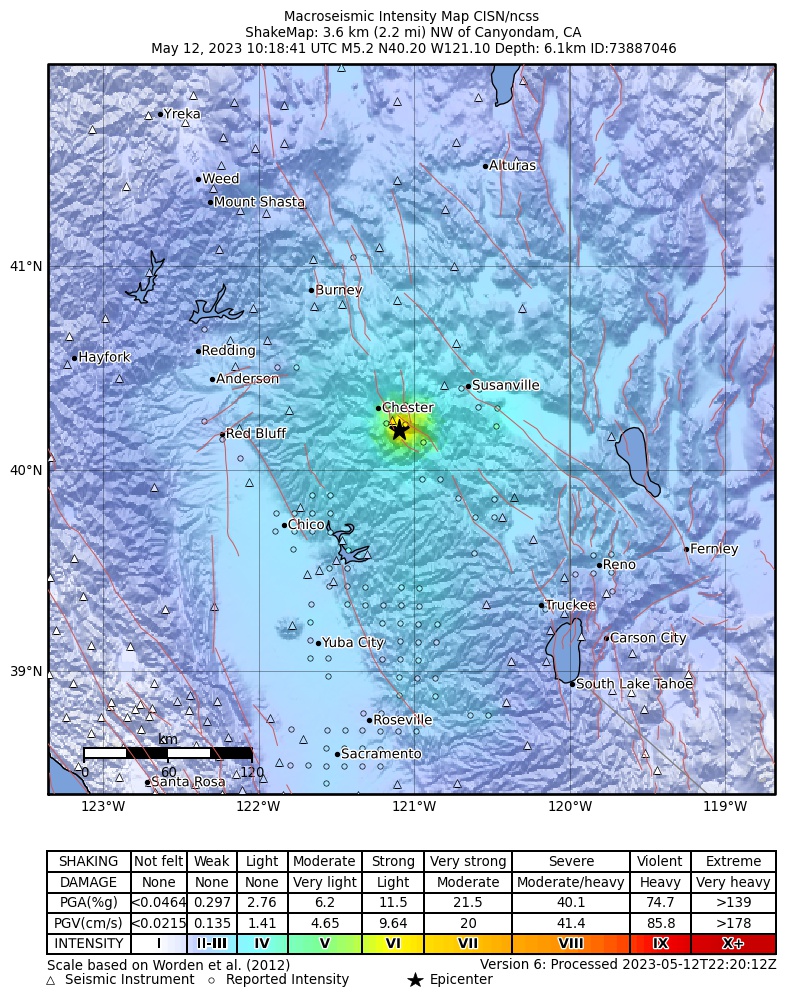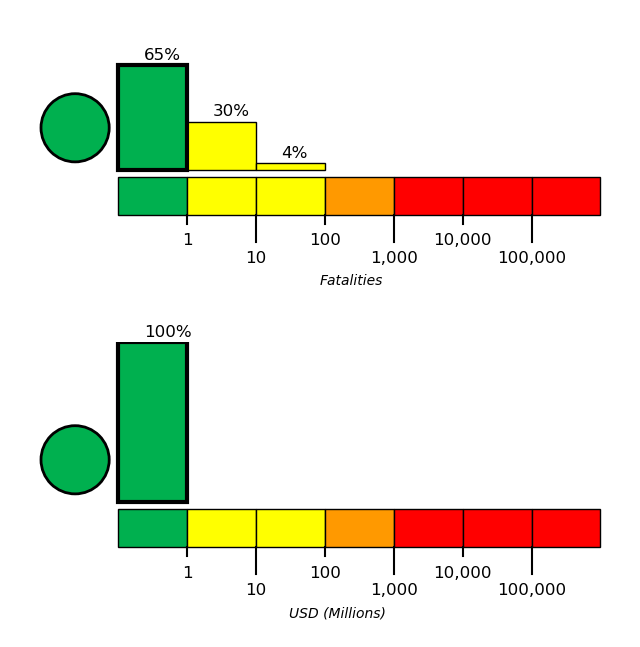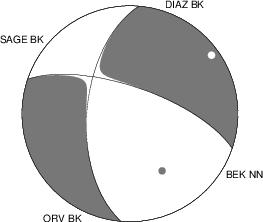Generating page for event nc73886731...

5.48, Lake Almanor Earthquake
Disclaimer: This information is intended solely for research and should not be used for communications with the media or the public.
Table Of Contents
Mainshock Details
(top)
Information and plots in the section are taken from the USGS event page, accessed through ComCat.
| Field | Value |
|---|
| Magnitude | 5.48 (mw) |
| Time (UTC) | Thu, 11 May 2023 23:19:41 UTC |
| Time (UTC) | Thu, 11 May 2023 23:19:41 UTC |
| Location | 40.204166, -121.1095 |
| Depth | 5.85 km |
| Status | reviewed |
USGS Products
(top)
Nearby Faults
(top)
4 UCERF3 fault sections are within 10km of this event's hypocenter:
- Almanor 2011 CFM: 1.66km
- Keddie Ridge 2011 CFM: 5.83km
- Skinner Flat 2011 CFM: 6.46km
- Walker Spring 2011 CFM: 7.99km
Sequence Details
(top)
These plots show the aftershock sequence, using data sourced from ComCat. They were last updated at 2023/05/15 16:15:24 UTC, 3.71 days after the mainshock.
75 M≥0 earthquakes within 10 km of the mainshock's epicenter.
| First Hour | First Day | To Date |
|---|
| M 0 | 9 | 54 | 75 |
| M 1 | 9 | 54 | 75 |
| M 2 | 9 | 50 | 70 |
| M 3 | 0 | 4 | 4 |
| M 4 | 0 | 1 | 1 |
| M 5 | 0 | 1 | 1 |
Magnitude Vs. Time Plot
(top)
This plot shows the magnitude vs. time evolution of the sequence. The mainshock is ploted as a brown circle, and aftershocks are plotted as cyan circles.
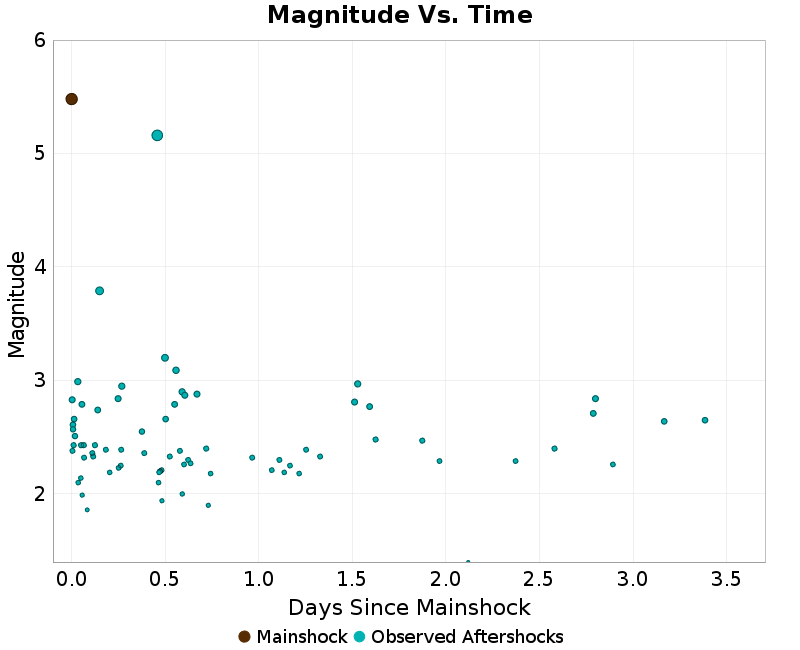
Aftershock Locations
(top)
Map view of the aftershock sequence, plotted as cyan circles. The mainshock is plotted below as a brown circle, but may be obscured by aftershocks. Nearby UCERF3 fault traces are plotted in gray lines, and the region used to fetch aftershock data in a dashed dark gray line.
| First Day | To Date |
|---|
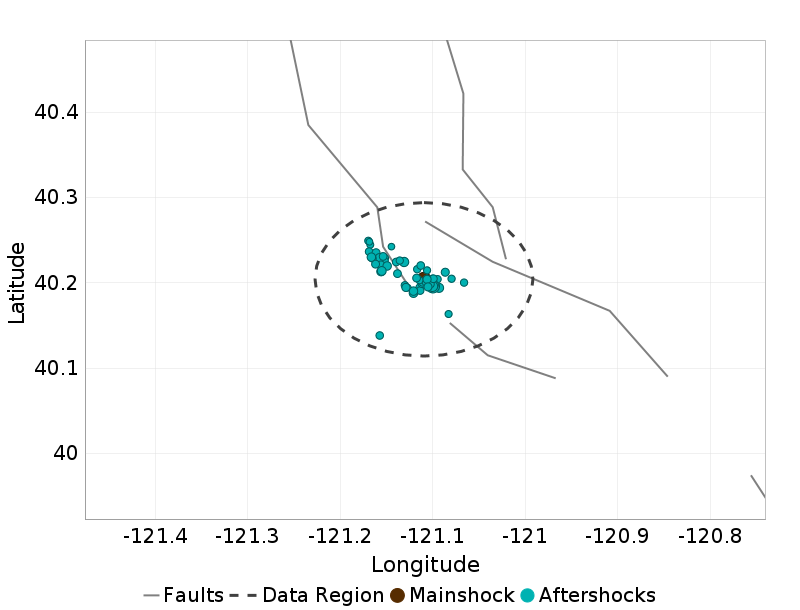 |  |
Cumulative Number Plot
(top)
This plot shows the cumulative number of M≥0 aftershocks as a function of time since the mainshock.
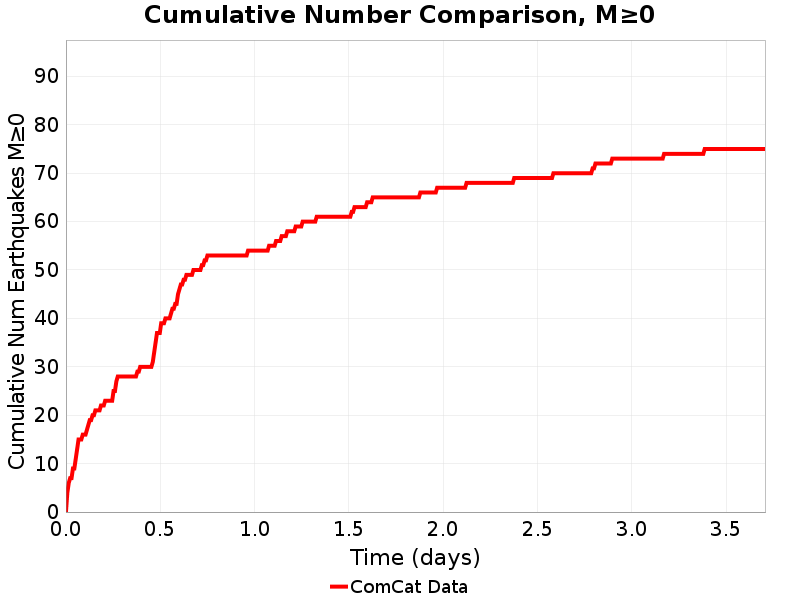
Magnitude-Number Distributions (MNDs)
(top)
These plot shows the magnitude-number distribution of the aftershock sequence thus far. The left plot gives an incremental distribution (the count in each magnitude bin), and the right plot a cumulative distribution (the count in or above each magnitude bin).
| Incremental MND | Cumulative MND |
|---|
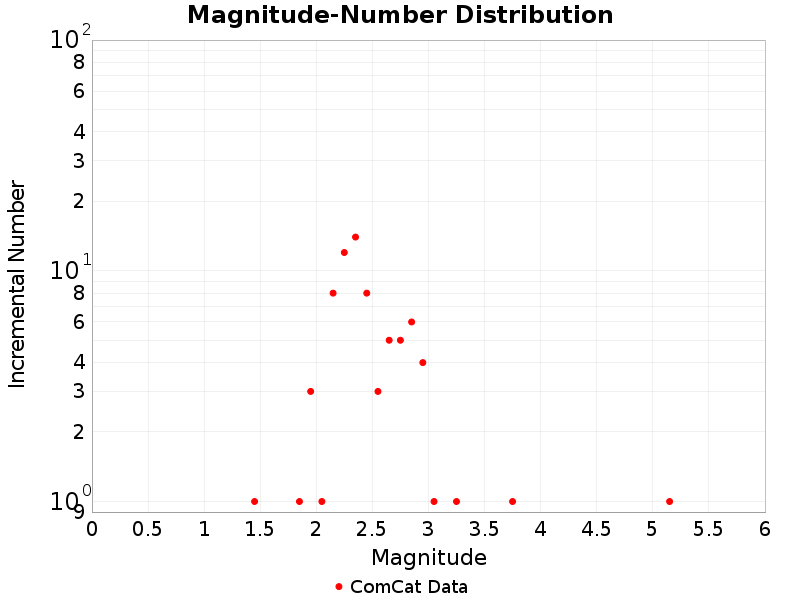 | 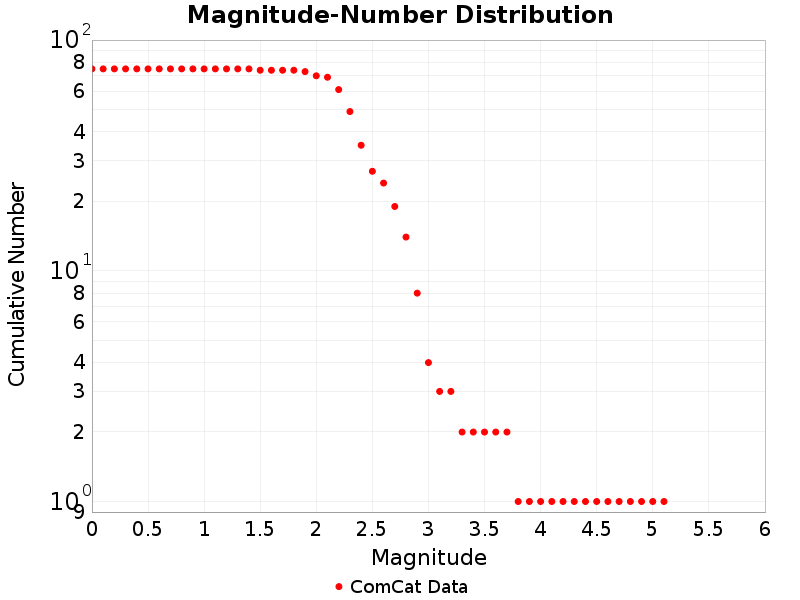 |
Significant Aftershocks
(top)
Aftershocks(s) with M≥6 or with M≥MMainshock-1.
M5.16 0.46 days after
(top)
Information and plots in the section are taken from the USGS event page, accessed through ComCat.
| Field | Value |
|---|
| Magnitude | 5.16 (mw) |
| Time (UTC) | Thu, 11 May 2023 23:19:41 UTC |
| Time (UTC) | Thu, 11 May 2023 23:19:41 UTC |
| Location | 40.196, -121.09983 |
| Depth | 6.06 km |
| Status | reviewed |
USGS Products
(top)
Nearby Faults
(top)
4 UCERF3 fault sections are within 10km of this event's hypocenter:
- Almanor 2011 CFM: 2.31km
- Skinner Flat 2011 CFM: 5.31km
- Keddie Ridge 2011 CFM: 6km
- Walker Spring 2011 CFM: 7.62km
UCERF3-ETAS Forecast
UCERF3-ETAS Forecast
(top)
This section gives results from the UCERF3-ETAS short-term forecasting model. This model is described in Field et al. (2017), and computes probabilities of this sequence triggering subsequent aftershocks, including events on known faults.
Probabilities are inherantly time-dependent. Those stated here are for time periods beginning the instant when this report was generated, 2023/05/15 09:13:37 PDT. The model was updated with all observed aftershcoks up to 23.1 hours after the mainshock, and may be out of date, especially if large aftershocks have occurred subsequently or a significant amount of time has passed since the last update.
Results are summarized below and should be considered preliminary. The exact timing, size, location, or number of aftershocks cannot be predicted, and all probabilities are uncertain.
This table gives forecasted one week and one month probabilities for events triggered by this sequence; it does not include the long-term probability of such events.
| 1 Week | 1 Month |
|---|
| M≥3 | 88.437% | 98.554% |
| M≥4 | 21.574% | 37.972% |
| M≥5 | 2.884% | 5.754% |
| M≥6 | 0.535% | 1.089% |
| M≥7 | <0.001% | 0.001% |
ETAS Forecasted Magnitude Vs. Time
(top)
These plots show the show the magnitude versus time probability function since simulation start. Observed event data lie on top, with those input to the simulation plotted as magenta circles and those that occurred after the simulation start time as cyan circles. Time is relative to the mainshock (M5.48, nc73886731, plotted as a brown circle). Probabilities are only shown above the minimum simulated magnitude, M=2.5.
| One Week | One Month |
|---|
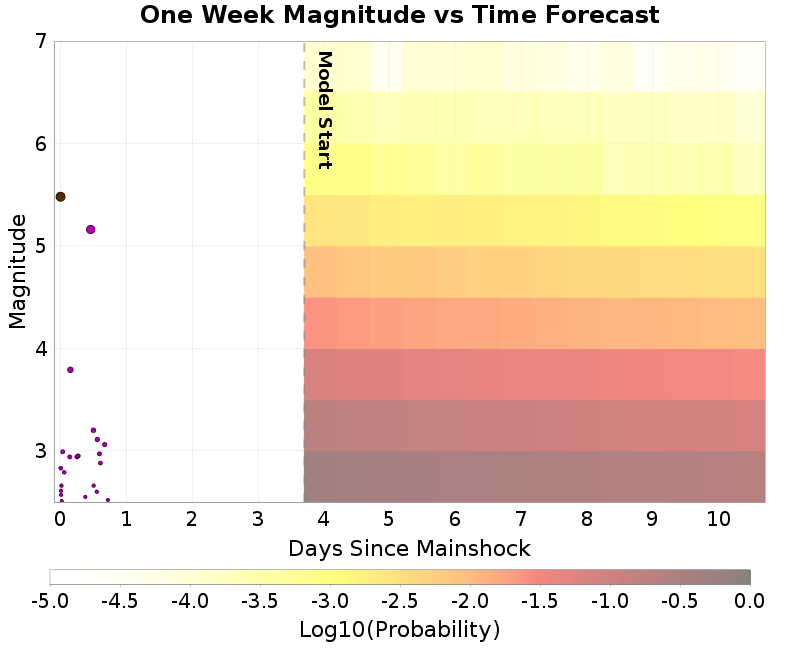 | 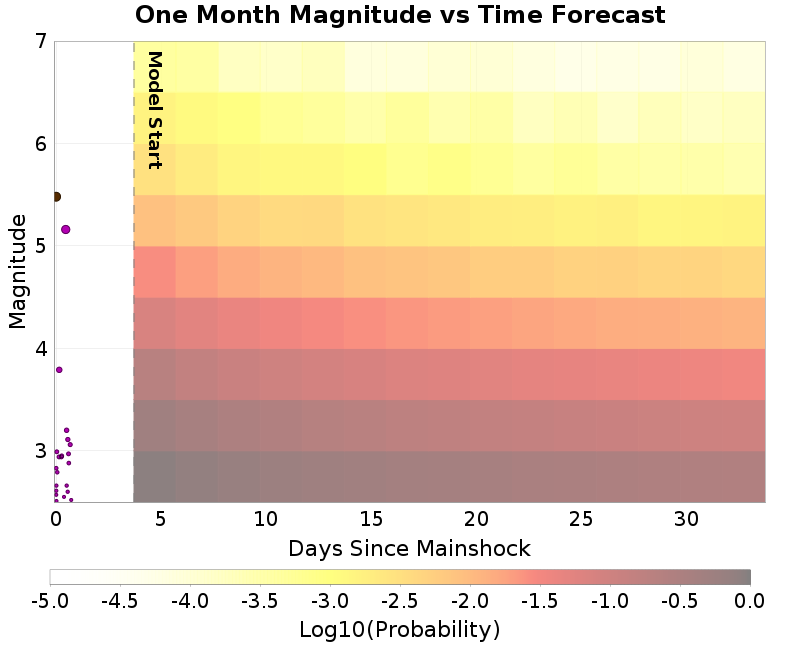 |
ETAS Spatial Distribution Forecast
(top)
These plots show the predicted spatial distribution of aftershocks above the given magnitude threshold and for the given time period. The 'Current' plot shows the forecasted spatial distribution to date, along with as any observed aftershocks overlaid with cyan circles. Observed aftershocks will be included in the week/month plots as well if the forecasted time window has elapsed.
| Forecast: 1 Week | Forecast: 1 Month |
|---|
| M≥3 | 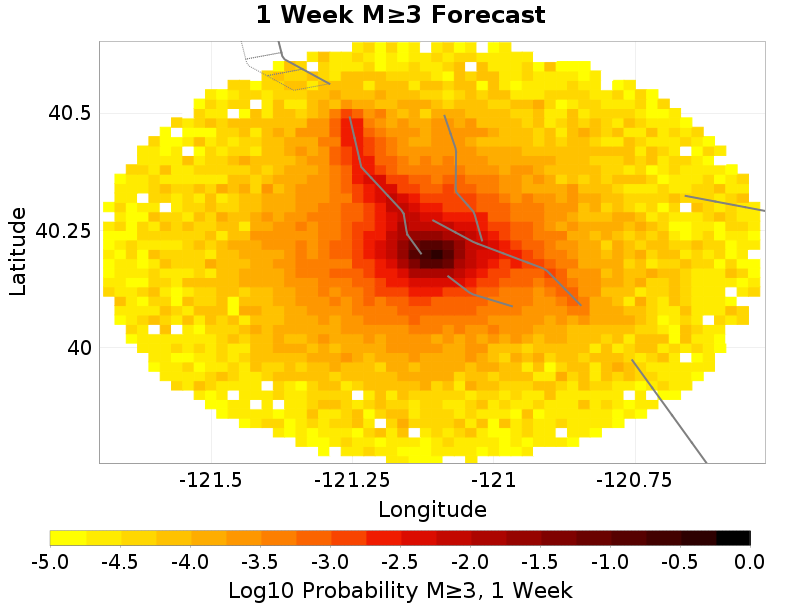 |  |
| M≥5 |  | 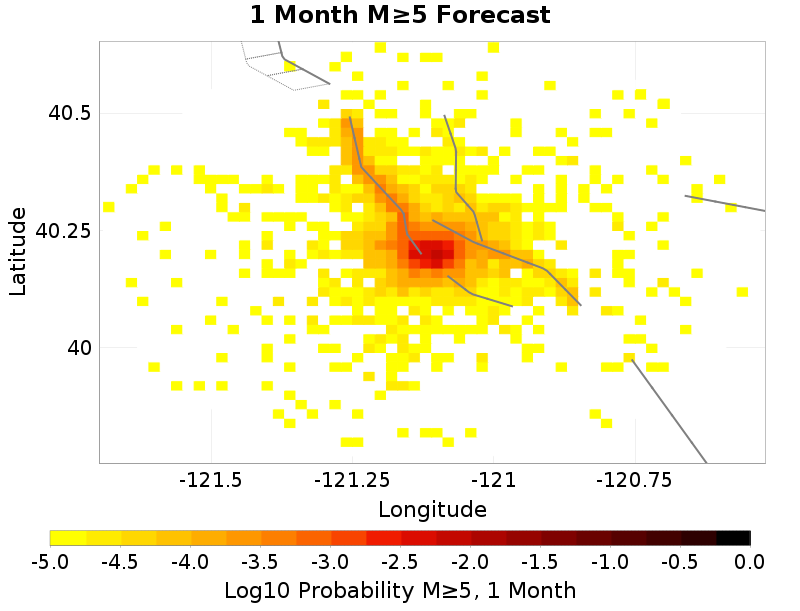 |
ETAS Fault Trigger Probabilities
(top)
The table below summarizes the probabilities of this sequence triggering large supra-seismogenic aftershocks on nearby known active faults.
| Fault Section | 1 wk supra-seis prob | 1 mo supra-seis prob | 1 wk M≥7 prob | 1 mo M≥7 prob |
|---|
| Almanor 2011 CFM | 0.393% | 0.810% | <0.001% | <0.001% |
| Keddie Ridge 2011 CFM | 0.170% | 0.347% | <0.001% | <0.001% |
| Walker Spring 2011 CFM | 0.030% | 0.056% | <0.001% | <0.001% |
| Skinner Flat 2011 CFM | 0.007% | 0.014% | <0.001% | <0.001% |
| Hat Creek-McArthur-Mayfield | 0.002% | 0.004% | <0.001% | <0.001% |
| Honey Lake 2011 CFM | 0.001% | 0.003% | <0.001% | <0.001% |
| Surprise Valley 2011 CFM | <0.001% | 0.001% | <0.001% | <0.001% |
| Cedar Mtn-Mahogany Mtn | <0.001% | <0.001% | <0.001% | <0.001% |
| Hunting Creek - Berryessa 2011 CFM | <0.001% | <0.001% | <0.001% | <0.001% |
| Swain Ravine - Spenceville | <0.001% | <0.001% | <0.001% | <0.001% |
Pre Event Seismicity Results
(top)

Figure 1. Seismicity Map
Map view of earthquakes (circles) with magnitude M2.0+ that occurred within 3 months and within 5 rupture lengths from the event considered (star). Circle size is proportional to magnitude (see legend) and color represents the time prior to the event considered (see colorbar).
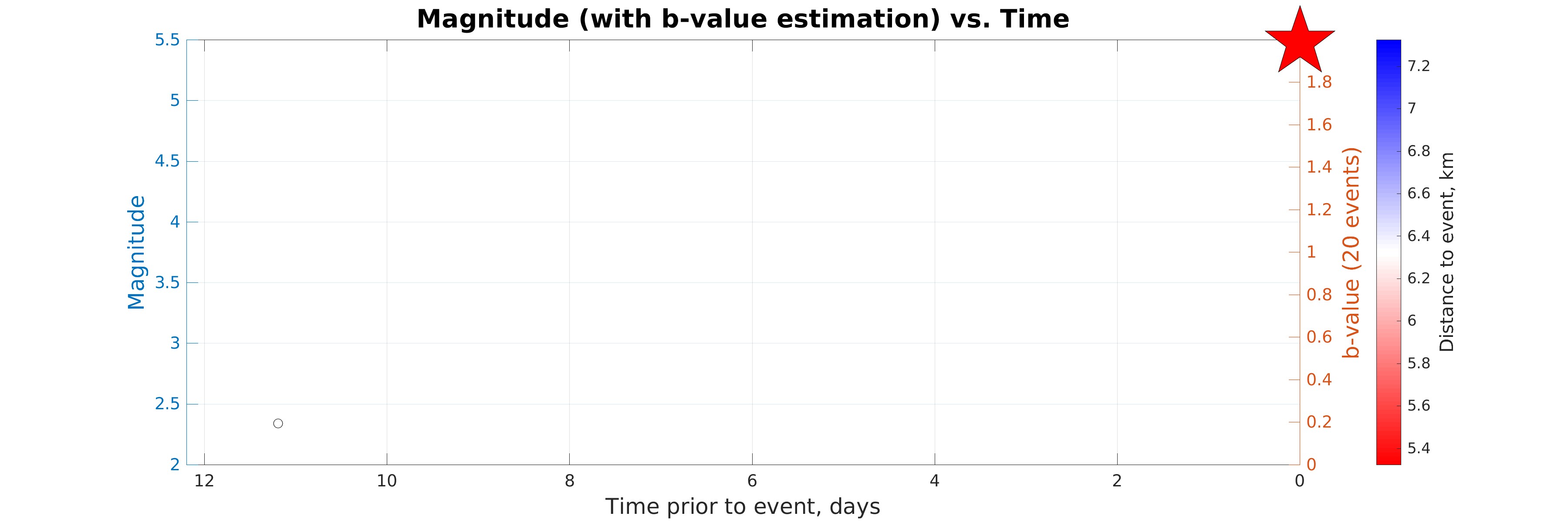
Figure 2. Magnitude (with b-value estimation) vs. Time
Magnitude (left axis) and b-value (right axis) vs. time of earthquakes in the seismicity map prior to the event considered (star). Color represents distance to the event (see colorbar). The b-value (gray line) is estimated within a sliding window of 20 days; results are only reported for windows with >5 events. The gray dashed lines correspond to a 95% CI for the b-value. The b-value estimation and confidence intervals are according to Tinti and Mulargia (1987).
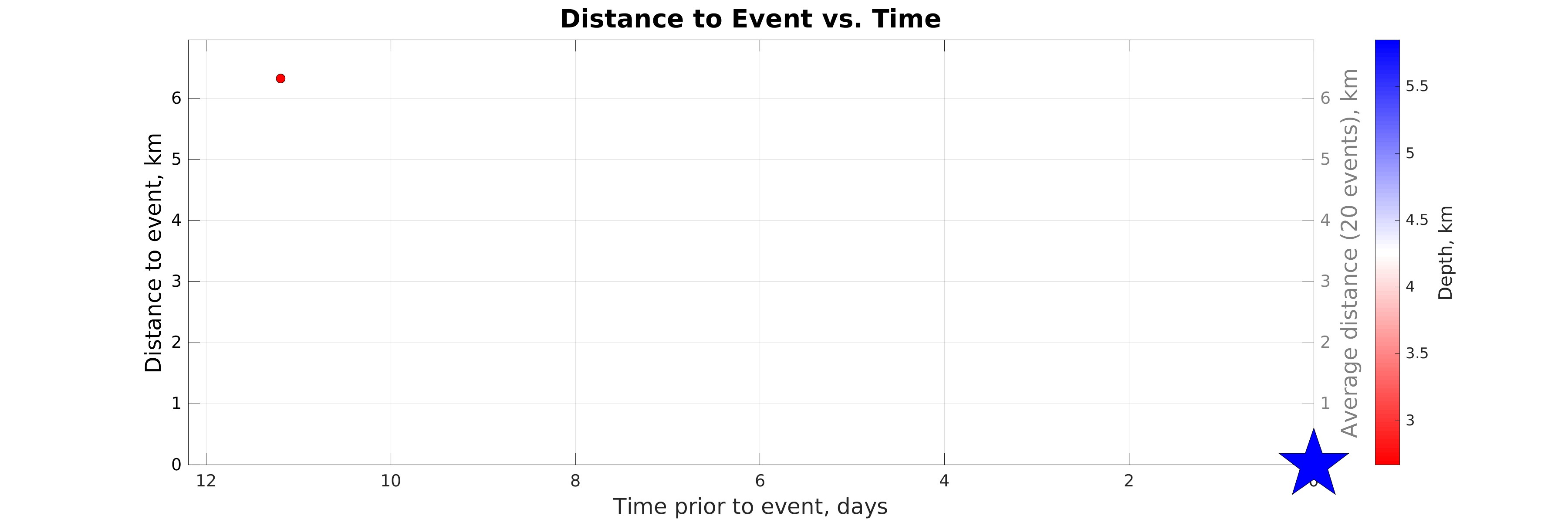
Figure 3. Distance vs. Time
Distance (left axis) vs. time of earthquakes in the seismicity map prior to the event considered (star). Color represents hypocentral depth (see colorbar). The gray line shows distance to event considered averaged within sliding time window of 20 events.
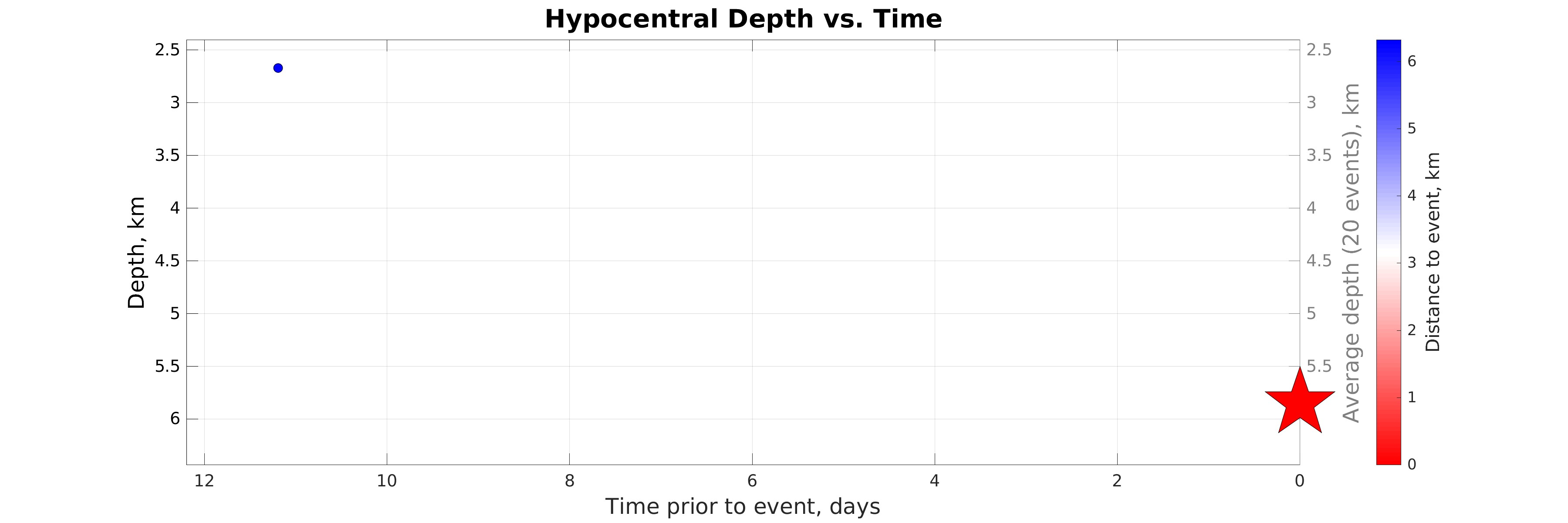
Figure 4. (Depth vs. Time)
Hypocentral depth (left axis) vs. time of earthquakes in the seismicity map prior to the event considered (star). Color represents distance to the event considered (see colorbar). The gray line shows the depth averaged within sliding time window of 20 events.
